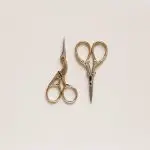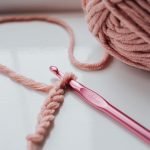Are you tired of your Tunisian crochet projects curling up at the edges? It can be frustrating to spend hours working on a beautiful piece, only to have it curl and not lay flat. But don’t worry, there are several techniques you can try to prevent this from happening.
In this article, we will explore the reasons why Tunisian crochet curls, and provide you with practical tips to keep your projects flat. From adjusting your tension to incorporating different stitches, we’ll cover all the ways you can ensure your Tunisian crochet projects look their best.
So grab your hook and let’s get started!
Table of Contents
Understanding Why Tunisian Crochet Curves
If you’re wondering why your Tunisian crochet is curling, it’s because the fabric has a natural tendency to contract in the width, causing the edges to curl inward.
This happens because the Tunisian stitch creates a dense and tight fabric, which results in a lack of drape and flexibility. As a result, the edges of the fabric curl inwards towards the center, making it difficult to use the fabric for flat projects such as blankets, scarves, and rugs.
To prevent curling, you need to understand the nature of the Tunisian stitch and how it affects the fabric. One way to do this is to experiment with different hook sizes and yarn weights to find the right combination that works for you.
You can also try blocking the fabric by wetting it and laying it flat to dry, which will help stretch out the edges and make them lie flat.
Another way to prevent curling is to add a border to the edges of the fabric. This can be done by using a different stitch pattern or by adding a row of single crochet stitches around the perimeter of the fabric.
This will help stabilize the edges and prevent them from curling inward. With these tips in mind, you can create beautiful Tunisian crochet projects without worrying about curling edges.
Adjusting Your Tension
You may be wondering why your Tunisian crochet projects always seem to curl. Well, inconsistent tension could be the culprit. That’s why it’s important to maintain a consistent tension throughout your work.
If you’re struggling to keep your tension consistent, don’t worry, we’ll show you how to adjust it.
Importance of Consistent Tension
Maintaining a consistent tension is key to preventing curling in your Tunisian crochet project. When you crochet with inconsistent tension, your stitches will vary in size, causing your piece to warp and curl. To achieve a consistent tension, pay attention to the amount of pressure you apply to your hook and yarn. Make sure to hold your hook and yarn at a comfortable angle to avoid straining your wrist or hand.
Another way to maintain consistent tension is to keep track of your gauge. Gauge refers to the number of stitches and rows per inch in your crochet project. By checking your gauge regularly, you can ensure that your stitch size remains the same throughout your project. To help you keep track of your gauge, use the table below to record your stitch and row count. Remember to measure your gauge after blocking your project to get the most accurate measurement.
| Stitch Pattern | Stitch Count | Row Count |
|---|---|---|
| Tunisian Simple Stitch | 10 stitches | 10 rows |
| Tunisian Knit Stitch | 11 stitches | 10 rows |
| Tunisian Purl Stitch | 9 stitches | 10 rows |
| Tunisian Full Stitch | 8 stitches | 10 rows |
By maintaining a consistent tension and checking your gauge regularly, you can prevent curling in your Tunisian crochet project. Remember to take breaks and stretch your hands to avoid fatigue and strain. Happy crocheting!
How to Adjust Your Tension
To fine-tune your tension, try experimenting with the pressure you apply to your hook and yarn while working on your project. If your stitches are too loose and your work is curling, try tightening your tension by applying more pressure to both your hook and yarn.
On the other hand, if your stitches are too tight and your work is bunching up, try easing up on the pressure.
To adjust your tension, you can also try changing the way you hold your hook and yarn. Experiment with holding your hook and yarn more loosely or tightly to find the right balance for your project.
Remember, it may take some practice to perfect your tension, so don’t be discouraged if it takes a few tries to get it just right. With some patience and persistence, you’ll be able to keep your Tunisian crochet from curling and create beautiful, smooth projects.
Using a Larger Hook
Using a bigger hook can be a game-changer when it comes to preventing curling in Tunisian crochet! This is because a larger hook will create larger stitches, which will result in a looser fabric. When your fabric is looser, it won’t pull in on itself as much, and the edges won’t curl.
When using a larger hook, it’s important to remember that you’ll need more yarn than you would with a smaller hook. This is because the bigger stitches will use up more yarn. It’s also important to keep an eye on your tension and make sure you’re not pulling too tightly on your yarn. If you do, your fabric could still end up curling.
Keep in mind that using a larger hook will change the look and feel of your finished project. If you’re making something like a scarf or blanket, this might not be an issue. But if you’re making something that needs to fit a specific size, like a garment, using a larger hook could throw off your gauge and make the finished piece too big.
So, before you switch to a bigger hook, make sure it’s the right choice for your project.
Blocking Your Project
After you finish your project, dampening it and stretching it out to its desired dimensions will help flatten any curling edges, resulting in a more professional look. This process is called blocking. Blocking can be done with either steam or water, but it is important to remember that different fibers react differently to different methods of blocking.
To block your Tunisian crochet project, you will need to wash it first. Gently wash your project in cold water with a mild detergent. Do not wring or twist your project, as this can cause damage. Instead, press out the excess water with a clean towel.
Next, you will need to stretch your project to its desired dimensions. Use a blocking mat or towel and rust-proof pins to hold your project in place while it dries. You can also use a steam iron or garment steamer to help set your project in place. Once your project is dry, remove the pins and your project should be flat and ready to use.
| Blocking Tips | |||
|---|---|---|---|
| Use rust-proof pins to avoid staining your project. | |||
| Always wash your project before blocking. | |||
| Be sure to use a blocking mat or towel to avoid damaging your work surface. | |||
| Different fibers may require different methods of blocking. | It’s important to follow the specific blocking instructions for your chosen fiber. |
Adding a Border
Now that you’ve learned how to block your Tunisian crochet project, let’s talk about adding a border. Adding a border not only gives your project a more finished look, but it can also help to prevent curling edges.
To add a border, you’ll first need to choose a stitch that complements your project. You can use the same stitch that you used for your main project or choose a different one for contrast. Once you’ve chosen your stitch, start by working a row of single crochet around the edge of your project. This will create a solid foundation for your border and help to prevent it from pulling inwards.
Next, you can start working your chosen border stitch. You can keep it simple with a row of single crochet or get more creative with a combination of stitches. To really make your border pop, consider using a contrasting color or a different texture. The possibilities are endless!
Here are two benefits of adding a border to your Tunisian crochet project:
- It gives your project a more finished look.
- It can help to prevent curling edges.
Here are two tips for adding a border to your Tunisian crochet project:
- Choose a stitch that complements your project.
- Consider using a contrasting color or texture to make your border pop.
Incorporating Different Stitches
Incorporating different stitches adds variety and interest to your Tunisian crochet project. By changing up the types of stitches you use, you can create a more textured and visually appealing piece. Plus, using different stitches can also help prevent curling in your project.
Here are some stitches you can try incorporating into your Tunisian crochet project:
| Stitch | Description | Best Used For |
|---|---|---|
| Tunisian Knit Stitch | Creates a knit-like texture on right side, purl-like texture on wrong side | Scarves, blankets, sweaters |
| Tunisian Simple Stitch | Basic stitch, creates a dense fabric | Coasters, dishcloths, bags |
| Tunisian Purl Stitch | Creates a purl-like texture on right side, knit-like texture on wrong side | Cowls, hats, mittens |
| Tunisian Honeycomb Stitch | Creates a beautiful textured pattern | Afghans, shawls, wraps |
By using a combination of these stitches, you can create a unique and beautiful piece that won’t curl. Experiment with different stitch combinations and see what works best for your project. Happy crocheting!
Practice and Patience
Practicing regularly and having patience with yourself is key to mastering the different stitches and creating a visually stunning Tunisian crochet project. Tunisian crochet tends to curl due to the nature of the stitch and the tension used.
The more you practice, the better your tension control becomes, and the less curling your work will have. When starting out with Tunisian crochet, it’s important to keep in mind that it takes time to become proficient in the technique. Don’t get discouraged if your first few projects curl or don’t turn out as expected.
With each project, you’ll learn something new and improve your skills. Take your time and enjoy the process. In addition to regular practice and patience, it’s also helpful to experiment with different hook sizes and yarn weights to find the perfect combination for your project. This can help alleviate some of the curling that may occur.
Remember, Tunisian crochet is a beautiful and versatile technique that can be used for a variety of projects. With practice and patience, you’ll be able to create stunning pieces that don’t curl and showcase your skills as a Tunisian crocheter.
- 5 Simple Steps to Clean Any Fabric Phone Case (Google, Speck, and More) - June 25, 2025
- How to Clean a White Fabric Phone Case and Make It Look New Again - June 25, 2025
- A Complete Guide to Washing Your Fabric Ipad Case Without Damage - June 25, 2025




